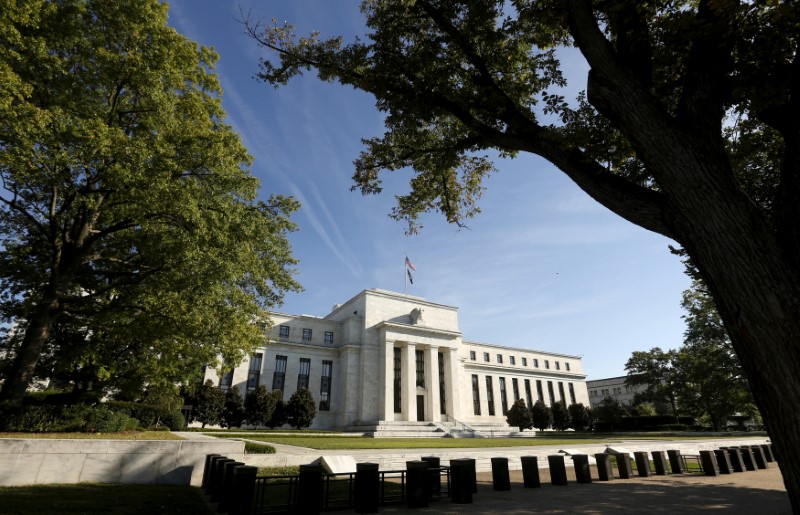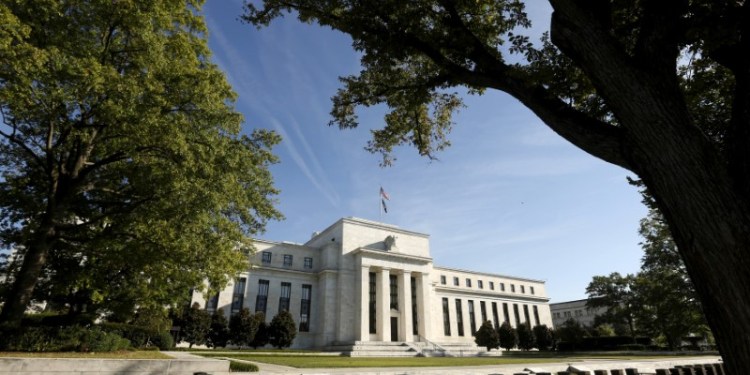 © Reuters. FILE PHOTO: The Federal Reserve building in Washington
© Reuters. FILE PHOTO: The Federal Reserve building in WashingtonBy Ann Saphir and Howard Schneider
PALO ALTO, Calif./AMELIA ISLAND, Fla. (Reuters) – The Federal Reserve is entering new terrain in its post-crisis planning: how to describe the conditions under which it would try to slow the economy and to do so without alarming financial markets.
The Fed’s gradual interest-rate hikes are bringing it ever closer to a shift to a neutral stance from “accommodative” policies, the first time it will face such a transition since its rate-hiking cycle in 2004-2006. None of the policymakers charged with overseeing the move today were in that position then.
“What is the message we should be sending out to accompany that move?” Atlanta Fed president Raphael Bostic said in an interview with Reuters on Friday.
The inflection point comes after many of the certainties of central banking were shattered by the 2008 financial crisis, and the Fed has spent more time trying to stimulate inflation than control it in the past decade.
At the same time, the old math – low unemployment equals rising inflation equals the need to slam on the brakes using higher interest rates – no longer works as it once did.
That can make it harder to formulate the right message.
The Fed needs to think “in terms of sending signals about what performance metrics we are thinking about or looking at, what dynamics are shaping our thoughts on the upside and to the downside,” Bostic said. “All those sorts of things become significant.”
Similar questions are being asked across the wider Fed system, according to three people familiar with the discussions who declined to speak openly because no decisions have been made. Minutes from the Fed’s March meeting showed that some policymakers were already flagging the need to acknowledge the coming transition to neutral or even restraining policy “at some point.”
One issue under consideration is the continued use of “forward guidance,” a communication tool used by central banks across the globe during the era of ultra-low rates in which they pledged to do “whatever it takes” to reflate the economy.
The Fed may feel the need to reassure financial markets that policy tightening to the neutral rate, something that could happen by the end of this year, will not be followed by a ratcheting of interest rates so high that recession would follow.
But forward guidance, which mitigates risk for financial institutions, spurring needed investment during an economic slowdown, may be controversial as it is not seen as appropriate for ‘normal’ times when it can stoke instability.
Speaking in Zurich on Tuesday, Fed Chairman Jerome Powell said the central bank “will communicate our policy strategy as clearly and transparently as possible to help align expectations and avoid market disruptions.”
CROSSING AN INVISIBLE LINE TO NEUTRAL
The Fed began raising rates in December 2015. In every post policy-meeting statement since, it has repeated its promise to keep policy loose “for some time” to encourage employment, economic growth and to rekindle inflation.
Now, with unemployment at 3.9 percent, and inflation nearly at the Fed’s 2-percent inflation objective, that promise is starting to sound stale.
The Fed also describes its policy as “accommodative,” which is less and less tenable as benchmark rates, now in a range of 1.50-1.75 percent, rise toward the Fed’s estimate of neutral, somewhere between 2.3 percent and 3.5 percent.
The Fed expects to raise rates at least two more times this year, to between 2 and 2.25 percent. Nearly half of Fed policymakers expect an additional increase this year, putting rates squarely within the estimated range for neutral. (For a graphic please see https://tmsnrt.rs/2rqX9F1)
As they weigh revisions, policymakers are sensitive to the ramifications of any communication misstep. In 2013, when Fed Chairman Ben Bernanke unexpectedly suggested that the central bank would soon scale back its bond purchases, a sharp global selloff ensued.
“We don’t want to freak out the market,” Bostic said.
WHAT TO DO AND WHEN
Another key issue any new statement may need to address will be how far the Fed would tolerate inflation going above its 2-percent target before it would need to put on the brakes, Bostic said.
The transition is further complicated by the Fed’s slimming but still-large balance sheet that continues to deliver some accommodation even as short-term rates rise.
And there is the question of timing: ditch the stale language ahead of hitting a neutral level of rates, or only after? And do it in one go, or piecemeal?
During the 2004 to 2006 tightening cycle, the Fed simply dropped the word “accommodative” from its statement after rates had crossed above its estimate of the long-run neutral and had become restrictive, Goldman Sachs (NYSE:) analysts have shown.
“My impulse would be to have (the new message) out before we actually got (to neutral), just so that there wasn’t so much to digest all at once,” Bostic said.
No matter what the decision, the process means a fraught several months ahead.
“We will have to make judgments as we go through this process, and once we get to neutral, what we should do from there,” Dallas Fed President Robert Kaplan said on Monday.
Source: Investing.com



























